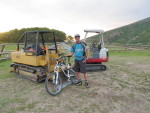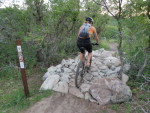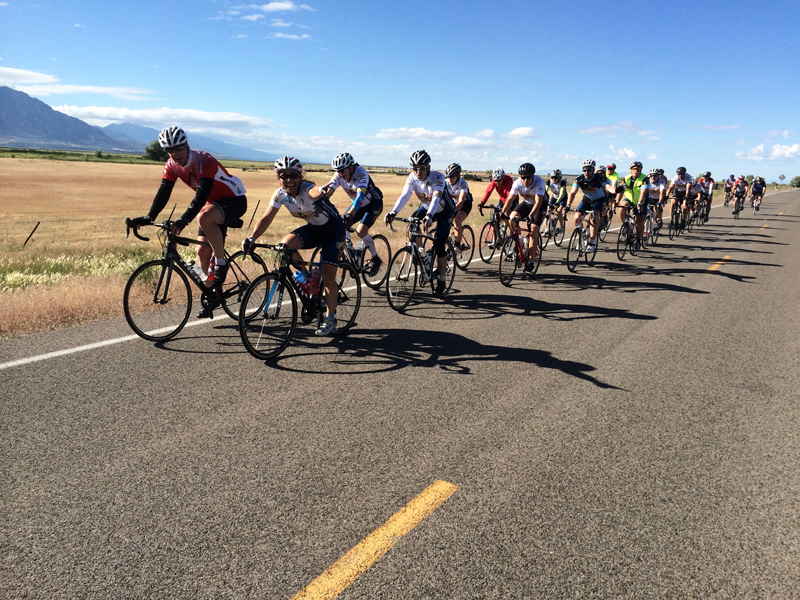By Lou Melini
InterContinental Hotel Group (IHG) received a Bronze award from the League of American Bicyclists as a bicycle friendly business. IHG will be our featured commuter profile for this Month. Steve Gerber took the lead in facilitating this interview for the group of riders at IHG. He is the 57-year-old Manager of Business Performance and Quality at IHG. Also contributing to this month’s commuter profile are Nate Briggs, Tom Taylor, Robby Morehead, Chuck Krivanek and Brett Cushing.
Cycling Utah: First of all, Congratulations on the award. Charles Pekow discussed how IHG received the award in the April issue of Cycling Utah, so I’m going to move on and talk to the individuals that made it happen. How did you guys decide to bike commute? Tell the readers a little about your commuting.
Steve Gerber: I was inspired by my co-worker, Nate Briggs, to start commuting by bike 5 or 6 years ago. I ride every day, year round except when the roads are too icy. I use my bike for shopping, errands, going to the gym, and almost anything I have to do within 5 or 10 miles of home.
Nate Briggs: When I was diagnosed with late onset diabetes in 1996, I found it hard to imagine any kind of exercise that I could do every day. Since I had bicycled some back in college, I turned to bicycling to try to extend my life and keep various body parts that are typically sliced off diabetics who are not exercising. It was only after riding for some time that I became interested in various alternative transportation issues.
I ride roughly 5 miles each way, 4 times a week. I like to add an additional 20 miles on Sundays. This usually takes the form of longer trips (Ogden, Provo) from time to time. The last 2 years have averaged 1,600 miles per year. This year I would like to push it up to 3,000.
I ride 12 months a year. We have 2 drivers in the house, but only one car. The bicycle is my primary mode of transport. I borrow my wife’s car when I need to carry something heavy – or I am under time constraints. Over the 13 years I have been commuting, eight years included riding part of my journey at night (after 9PM). I have a lot of nostalgia for that time, since I consider riding at night to be much simpler and safer.
Tom Taylor: I’ve always been a bike rider. I had a paper route from 12 – 16 years old (BMX-bike powered). I used to take long distance road-bike rides with friends in the neighborhood growing up. I went to Dixie State University in St. George UT, where I participated heavily in off-road and mountain biking. As far as commuting to work via bike is concerned, as a one-car-family, I found that on occasion, it could be difficult to get everyone where they needed to be when they need to be, etc. I brought this up during some conversations with a few co-workers who bike commuted, and was challenged to start biking to work. They talked of the benefits and I, thinking back on my bike riding past, thought it would be a good idea to at least try it once. It would be nice to let my wife have the car, and the exercise couldn’t hurt either. That was in May of 2008. I’ve been riding to work ever since.
My ride is approximately 6 miles to work (12-ish round trip). I live in Rose Park and my office is around 21st South and Redwood Road. It is flat the entire way (thank goodness). I ride south on 1000 west to 800 south, then ride west about a block and catch the Jordan River Parkway Trail south almost to the front door of my office! It is very convenient. I try to ride as frequently as possible. I ride year-round, unless there’s a lot of snow on the ground. I ride at night as well and employ front headlight and rear taillights, as well as reflectors.
Robby Morehead: I was cajoled into biking to work by some of my co-workers in May 2009, and I’ve been riding regularly since June 2009. I needed the exercise and it turned out to be fun, too. I bike 5.5 – 6 miles each way, and my goal is to ride to and from work at least three of the five workdays each week. My commute is almost exclusively North-South. I take 1000 West from 800 North to 800 South; then the Jordan River Parkway from 800 South to about 2200 South where my office is located. It’s a great commute because the river is so pleasant and 1000 West is a pretty quiet street with a bike lane for much of the way. The only busy intersection is 1000 West and North Temple, but it’s not a big deal. It would be perfect if the city would complete the Jordan River trail from 200 South at the old Fisher Mansion to the Liquor Store on North Temple, then I could ride the trail for probably 90% of my commute! I have had no problem riding year round after investing in some cold-weather gear; I’ve found I’m fine to ride in temps as low as 15 or 20 degrees, but lower than that and I’ll be driving. We have two cars in our family so we are definitely not “car-free”, but probably “car-lite” as one of the cars (the one that gets poorer gas mileage) sits in our driveway on the days I ride to work. I also ride to the store, library, post office, etc. in my neighborhood in the evenings and on weekends as opposed to driving. My kids like to ride with me around the neighborhood streets and run errands with me.
Chuck Krivanek: I started two summers ago, just a few times that summer at the insistence of a co-worker. Then last summer I rode as much as I could…typically 3-4 times a week. I almost never use my car on the weekends in summer because I live a short distance to almost everything I need in Sugarhouse, so I either walk or ride. My work commute is about 6 miles roundtrip and takes me down 17th south and along the Jordan River Parkway. My only barrier to riding year round is that I still have to make sure my boys get to school on time and it’s a little too far and in the opposite directions for walking/biking…but summer break takes care of that barrier. I actually considered buying a new car however I decided to buy a new bike instead since I hope to continue to bike more than drive. I take 17th South from about 840 East to the Jordan River Parkway…one tricky area is at 17th South and 7th East mostly on the way home (headed east) as traffic backs us there and the rode narrows a bit. Oh, and at 5th East and 17th, the side of the rode is really rough and again narrow…it’s a kidney shaker. The rest of my ride is smooth unless I get a flat.
Brett Cushing: I got started in bike commuting at the insistence of my good friend, Steve Gerber. I was looking for a good way to exercise and he was looking to get more miles in his commute. Our agreement began with a “Manager’s Bike To Work” event sponsored by the management team here at IHG in early 2009 and continued through the summer. The door-to-door distance from home to office is approximately 7.5 miles and the route is almost exclusively along our local Jordan River Parkway, which winds through the heart of the Salt Lake Valley along the riverside. I don’t ride year-round currently due to my distaste for freezing weather and exposure to ice/snow (much to Steve’s disappointment). My riding hasn’t been enough to warrant going car-free or car-lite, but I definitely notice the reduced impact on my gas expenses. I have commuted home at night and although it isn’t my preference due to reduced visibility, necessity will dictate this type of travel 8-10 times a year.
C.U.: Steve, tell me about your bike and how do you guys deal with the thorns on the Jordan River Trail (JRT)?
S.G: I started commuting with an old mountain bike while I proved to myself that I would stick with it. After a couple of years I decided I could justify a new bike and purchased a Novara Randonee touring bike. I planned to take some loaded road tours, and thought the bike would be a good dual-purpose ride. I have rear panniers and a trunk bag, allowing me to carry a change of clothes for work, a laptop, and have plenty of room to carry groceries or whatever. I have a Planet Bike Super-Flash on the back and a Planet Bike 2W headlight. I also have a helmet cam mounted to my handlebars that makes for some interesting video! Most of us here in the office use panniers, although a couple use backpacks. I leave shoes at the office and bring fresh clothes every day. Through the years I figured out exactly what works and what I am likely to need. We all use what we call the “Parkway Package”, consisting of puncture resistant tires and tubes, slime, and tire liners, to minimize the puncture vine effect of the JRP. Our office is one block off the Parkway so most of us use it for at least a portion of our commute. Nate is the only one in the group to use an electric assist on his bike.
C.U.: The “No Stop” bicycle bill received quite a lot of email traffic among cyclists. What did you guys think of it?
Steve.: I am opposed to the bill. Every year we widen the divide between motorists and cyclists. As cyclists we keep demanding respect but we often behave in arrogant and disrespectful ways. I don’t think the average motorist would be aware of the law and seeing us cruise through signs and lights would just aggravate an already tense relationship.
Nate.: This bill just places a big, red target on the backs of bicycle riders – and could probably lead to another bill removing the designation of “vehicle” from bicycles entirely. The whole “momentum” argument is ridiculous. What we need is a street situation where laws are enforced – and observed – so everyone knows what to expect. Riders need to stop asking for special favors – and they need to stop behaving as though traffic laws are for everyone else. This is the only way that we can be taken seriously.
Chuck.: After considering all that this entails, I believe the safest way for cyclists to ride is to follow the rules of the road identical to autos. Since this is what most Motorists are used to, there should be no surprises when a cyclist acts the same way. Most times I see a bicycle/car accident, it’s when a bicyclist did something a motorist wasn’t expecting…like flying off a curb or running a light.
Brett: I am not in favor of the proposed legislation to allow cyclists to pass through stop lights/signs without stopping. This conflicts with the instincts of motorists and could cause potentially dangerous situations for all both motorists and cyclists. The only advantage I can see is convenience for cyclists, but legislation for the sake of convenience seems like a poor position.
C.U.: Steve, any comments on the Bronze award from the League of American Bicyclists?
S.G.: Bicycle commuting has become very popular in our office, with approximately 20 regular commuters. We were awarded a Bronze designation by the League of American Bicyclists as a Bicycle Friendly Business. We have set a goal to double the number of riders this year and have undertaken a number of initiatives to aid in the effort. We have a covered parking area now, but will be building a more substantial structure this spring. We are adding locker facilities for riders, a resource center with bike and commuting information, an emergency repair toolkit, a loaner bike, guaranteed rides home for bike commuters, mentoring for new riders, route mapping services, and organized ride-to-work days. We are aware of the Bicycle Commuter Act, but have been unable to take advantage of it yet.
C.U.: Nate, what thoughts do you have on Salt Lake City becoming a Silver City?
Nate: Positives: the completion of the Jordan River trail has made this commute much more enjoyable – and will probably be a big factor in our efforts to recruit more riders in the future (every public survey confirms that new riders are very fearful about mixing with traffic on public streets). As far as street infrastructure, Salt Lake has everything needed to become a Platinum city: exceptionally wide streets and a population interested in outdoor activities.
Here are my top five for improvements: 1) make it a priority that cops actually enforce traffic laws; 2) sweep streets with marked bicycle lanes more than once a month; 3) finish the Jordan River trail – link it all up; 4) design and build a viable east-west route – 8th South isn’t it – 17th South isn’t it; 5) do some pilot programs with physical barriers (rumble strips, concrete dividers, etc.) between automobile lanes and bicycle lanes. Extra bonus effort: close Main Street to motorized traffic – the current configuration doesn’t benefit anybody.
C.U.: Brett- riding the Jordan River Trail has its pro and cons. Talk about the trail.
Brett: The best part of my commute is the health benefit. Although I enjoy biking in a relative sense, the issue that keeps me motivated is the exercise itself. Outside of this primary advantage, another great aspect of my particular commute is the scenery. There are many portions where the landscape is quite nice, taking an almost rural perspective. Not having to take surface roads allows me to avoid the hustle & bustle of car traffic and promotes a feeling of relative safety. These benefits can come at a cost. The first is in the ever-present thorns that are scattered along the pathway and have caused more than a few flat tires. The second is from the river itself, which can sometimes flood the pathway and make passing quite difficult. A third disadvantage is from the presence of large swarms of insects, which can make for a rather nasty mess along the way.
C.U.: Steve, with the improvements that you described, the enthusiast core of bike commuters, and the support of upper management, you should be on the way for a gold designation.
Steve: That’s our hope, but in the meantime we will just enjoy our commutes to work. Lou, thanks for featuring us in your column. If you peddling in the area feel free to stop in, there is no shortage of bike nuts here!
Correction: In the April column there were 2 remarks made by the April bike commuter that Salt Lake City was not doing an adequate job of maintaining the trail. Mr. William Johnson pointed out to me that the section of the trail mentioned in the column was not in the jurisdiction of Salt Lake City. Mr. Johnson rides the Salt Lake City section of the Jordan River Parkway and had very positive remarks about Salt Lake City’s section of the JRT and the maintenance performed on the trail. Thanks to Mr. Johnson for his comments and correction.
This month’s commuter will receive a Blaze light set courtesy of Planet Bike. See PlanetBike.com for more info on their products. Many local dealers also carry their products.
This month’s commuter will also receive a $25 gift certificate courtesy of Saturday Cycles. Find out more at saturdaycycles.com.
If you have a suggestion for a commuter profile, have a commuter question you wish me to address, or other comments, please send them to [email protected].










